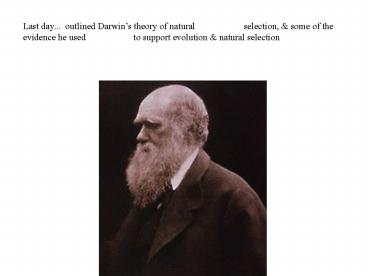Last day''' outlined Darwins theory of natural selection, - PowerPoint PPT Presentation
1 / 25
Title:
Last day''' outlined Darwins theory of natural selection,
Description:
when cross-bred, only dominant trait expressed in F1 ... combined with findings from paleontology, systematics, etc. The Modern Synthesis' ... – PowerPoint PPT presentation
Number of Views:45
Avg rating:3.0/5.0
Title: Last day''' outlined Darwins theory of natural selection,
1
Last day... outlined Darwins theory of natural
selection, some of the evidence he used to
support evolution natural selection
2
Also - Mendel discovery of rules of heredity
(1866)
- traits do not blend in offspring - when
cross-bred, only dominant trait expressed in F1
generation, but dominant (3/4) recessive
traits (1/4) both show up in F2 generation
3
Today, understand this occurs because
hereditary info is contained in genes
located on chromosomes
Most plants animals carry 2 sets of
chromosomes diploid
One set from mother (in egg), other set
from father (in sperm)
4
One gene (e.g. for flower color) has different
versions called alleles (e.g. purple or white)
5
Gene can be thought of as segment of DNA that
codes for a protein (or polypeptide)
Code is written using 4 bases Adenine Thymine Gua
nine Cytosine
6
Sequence of 3 bases codes for a particular amino
acid in the protein
7
How does this make a flower purple or white?
Purple allele codes for a protein that makes
flower purple
White allele may code for a defective protein
8
One copy of dominant purple allele produces
sufficient protein to turn flower purple
2 copies of same allele homozygous
1 copy each of different alleles heterozygous
Phenotype (observable characteristics of an
organism) does not always reveal the
genotype (set of genes or alleles an
individual has)
9
- Not all genetic characters
- work the same way
- some traits show
- incomplete dominance
- (heterozygotes show
- intermediate phenotype)
10
Another complication - some characters are
affected by gt1 gene, each gene may
have gt2 alleles
Quantitative characters typically show
continuous variation
11
Diploid organisms get one copy of gene from
mother and one copy from father
But parents have 2 copies of each gene - how does
it work so only one copy gets passed on?
12
Normal cell divisions (mitosis) produce 2
daughter cells with same set of genes as
original cell - no good for producing
gametes in diploid organisms
13
Gametes instead produced by meiosis -
reduction division that results in
haploid cells
- chromosomes replicate before meiosis -
diploid organisms now with 4 copies
of genes
14
- THEN 2 rounds of cell division,
- 4 daughter cells, not 2
- each haploid (1 copy of genes)
15
Meiosis does not just reduce chromosome number,
it also creates new gene combinations
- homologous chromosomes come together as pairs
- (tetrad), process called synapsis
- chiasmata form crossing-over of chromatids
16
Other ways of creating new gene combinations
- Independent assortment of chromosomes
- when chromosomes align during meiosis,
- chromosome from same parent may move
- into different cells
17
- Random fertilization
- combination of any sperm with any egg allows
trillions of possible combinations
18
New gene combinations detected by Mendel when he
crossed peas that differed in 2 characters
e.g. pea color (yellow or green) shape
(round or wrinkled
Original combinations were found, but also
new ones
How do new combos arise?
19
Ultimately, genetic variation must come from
mutation - many ways for this to happen...
Chromosomes may break fragments may be lost,
or added elsewhere
Errors also during crossing-over
20
deletion segment removed
- usually lethal
duplication segment repeated
- usually harmful
21
inversion segment in reversed position
reciprocal translocation fragments switched
between non-homologous chromosomes
- inversions translocations can change phenotype
- because gene expression may depend on
position
22
Point mutations (change in one nucleotide of DNA)
can be caused by chemicals, UV light,
errors in replication, etc.
- most repaired by enzymes
23
Most mutations are deleterious, some neutral (do
not change fitness), a very few are beneficial
- generally detrimental, but could not have
evolution - without them
Chapter 14 (esp. pp. 262-75)
24
Evolution after Mendel After Darwin, evolution
generally accepted but skepticism about
natural selection - poor understanding of
heredity a problem
Mendels paper noticed in 1900, theory of
heredity rapidly developed
Initially thought Mendelism was in conflict with
natural selection - emphasis on major
mutations causing discrete traits, not small
variations
25
Eventually, population genetics developed,
combined with findings from paleontology,
systematics, etc. ? The Modern Synthesis -
built on clarified Darwins theory
Sewall Wright
Ronald Fisher
J. B. S. Haldane































